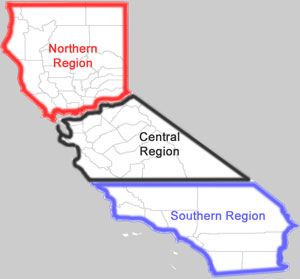Time to Carve Up California?
By MICHAEL WARNKEN
This issue of Splitting California into two or more states has come into the greater public eye once again. This matter is dredged up every few years by a different group of Californians who are not happy with current arrangements. A recent proponent was Riverside County Supervisor Jeff Stone.
However often the issue of splitting the state has been brought up, the actual splitting has never occurred. This leaves the question for many of us: How does a state get split? The further question that needs to be asked and answered is: What needs to occur in order to actually cause a State to split?
The process of splitting a state is codified in Article IV Section 3 of the U.S. Constitution:
“New States may be admitted by the Congress into this Union; but no new States shall be formed or erected within the Jurisdiction of any other State; nor any State be formed by the Junction of two or more States, or parts of States, without the Consent of the Legislatures of the States concerned as well as of the Congress.”
The state splitting process generally begins when a state’s legislature first votes to split the state. Once the measure passes both chambers of that state, it is submitted to Congress. Once there, the matter is discussed. If both chambers of Congress vote to pass it, the state can then be split.
There seem to be two options on how a state can split. In the first instance, the state decides how it’s going to be split before sending the proposal to Congress.
In the other instance, the state does not decide how to split itself before the bill is sent to Congress. Congress generally establishes a partition committee once the bill to split a state has been affirmed by Congress.
Partition committees are quite important to the splitting process. When a vote to split a state occurs, there are many details that must be worked out. These details include what resources are to be partitioned to which new state, how any existing state debt will be distributed between the two new states and how the state Constitution will be addressed or changed by the new states. A key component of a partition committee can include how to draw the lines and how many new states may be created. So, proponents may be a bit ahead of themselves by drawing such maps.
What If Congress Chooses Not to Act?
What happens if the state itself votes to split, but Congress either fails to take the matter up, or chooses not to? That was the case in 1864, when Californians passed a ballot initiative to split California and the Legislature voted and passed it as well. Unfortunately, Congress chose not to discuss it and the matter was left undecided. This poses a problem, but needs to be examined.
If an existing state is too small to divide and yet tries to split, it would be argued that Congress has a material interest in acting as a check to stop the process. If, for instance, Vermont tried to split itself into two or more parts, many would see that the resulting new states would be too small in both size and population and should not have the benefit of another U.S. House member, much less two more U.S. Senators.
However, considering the sheer size of California and its population, not to mention the size of our economy, some have suggested that California is a de facto country of its own. One would think that any attempt for California to split into two or more states would not run into the same problem.
In my opinion, Congress should vote to support California splitting. If Congress lets the issue die, as it did in the 1864, then we have a real dilemma.
California could have other options if Congress chooses not to act. Article IV, Section 4 of the U.S. Constitution guarantees:
“The United States shall guarantee to every State in this Union a Republican Form of Government….”
If Congress chooses not to pass such a split of California, that provision could be invoked in the the federal courts if manageable standards could be advanced. (I believe they could be.) Though it is not clear if such a process would be successful, it could help to build the political pressure needed to force a split.
The only other remedy to split a state is would be a direct appeal by California to the other states to call a Constitutional Convention, following Article V of the Constitution. The Convention would change the process of splitting a state. This would a very long and difficult procedure.
History of State Splitting in America
The very first state to split was New Jersey. For a brief time there was a West and East Jersey. This happened in 1676, but the experiment was short lived and the two parts were reunited in 1702 as modern day New Jersey. At that time, New Jersey was still a colony and it is not clear what caused the splitting or reunification to occur.
The next split to take place was Vermont. It was formed from the Northeast corner of New York state, in an area for which there were land claims by New York, New Hampshire and even Massachusetts. In 1777, the locals living in the area of this cross-claimed land themselves took title (it seems unilaterally) and formed “The Republic of New Connecticut,” declaring it an Independent country. Six months later, at a constitutional convention, 72 delegates adopted the name of Vermont.
In 1791, Vermont became the 14th state. It was Vermont’s circumstances that led to the creation of Article IV Section 3 at the Constitutional Convention held in Philadelphia by the Founding Fathers. They realized that there may be a need for states to split or even be able to combine two or more states into one. This is what led to the constitutional codification.
Maine became the first post-colonial state to split. It was a territory that the French and English fought many wars over until it was finally claimed by Massachusetts in the mid-18th Century. Maine is not physically attached to Massachusetts and was called “an exurb.” Until Maine was formed as its own state, representatives were sent to the Massachusetts statehouse to represent the citizens in the Maine territory.
In 1807, disputes over land grants in Maine led to a vote in the Massachusetts Assembly to split the state. That vote failed.
However, the first step to actually split did occur. There is one key reason why. Massachusetts was well represented in the lower chamber of its legislature in those days. In fact, there was about one representative for about every “150 ratable polls” (one representative for every 150 white men over age 21) in its lower chamber, far more than any other state at the time or even now. In 1812, there were representatives in the Massachusetts lower chamber. It is likely the high level of representation led to the state considering the split, even though the split was voted down.
During the War of 1812, the British captured and took control of Maine, but then it was released back to Massachusetts after the war. So, for a time, representatives were no longer sent to the Massachusetts legislature. Massachusetts finally voted to allow Maine to become a State in 1820 as part of the Missouri compromise to keep the balance of slave states and free states.
Virginia is the greatest splitter of all. It began as one of the first and oldest colonies and then grew to the point in which encompassed the area of West Virginia and Kentucky. It was these latter areas that separated from Virginia to form their own states that we recognize today.
Kentucky split from Virginia and became the 15th State in November of 1861 as part of the secession movement. Kentucky citizens formed a convention and voted to secede from Virginia. Kentucky does not appear to have invoked Article IV, Section 3 in its formation. It seems that this was done summarily after Virginia seceded from the Union.
West Virginia followed a similar pattern to Kentucky. Since Virginia became a Confederate state, the people residing in the northwestern portion of Virginia formed a convention and voted to break off from the greater state, like Kentucky not asking Virginia’s consent to split. West Virgnia simply applied to the U.S. Congress to become a state. The application was granted.
It appears that Maine is the only state to have split under Article IV Section 3.
How Could California Split?
There are many people who are not satisfied with the California’s current boundaries and others who believe that splitting the state would solve many internal problems. This is particularly true of people who feel they have no access to the Legislature or are simply being controlled by factions of the state who do not share their interests.
However, with the number of attempts that have been made, it is clear that a good deal more political will needs to be developed to advance a breakup.
The key question: What would need to happen in order to push a successful split forward? The answer lies with an issue more obscure than the intricacies of state splitting itself. The main problem is there needs to be an increase in the number of representatives in the California Legislature because the will of the people is not being expressed by this small Legislature.
Currently, California has 80 Assembly members and 40 Senators representing 28 million people.
In 1862, those same 80 Assembly members and 40 Senators represented just more than 400,000 people statewide. That is, each Assembly member in 1862 represented 5,000 people; and each state senator, 10,000.
James Madison noted in the Federalist Papers that each representative in a state legislature should represent about 3,000 people. He got that idea by looking to democracies throughout history that had successful representative government. So originally, California was not far from Madison’s ideal.
Representation in California has degraded to the extent that now each Assembly member has close to 500,000 constituents and each state senator has close to 1 million. It is almost impossible for the average person to ever even meet their representative, much less feel that their concerns are heard, understood and acted upon. The more people represented by each legislator, the more power and less accountability each has. This alone is a powerful incentive to maintain the current system. It also serves to defeat all attempts to split California.
If California ever increases the number of state representatives enough to correct the people’s incredibly poor access, the Legislature would likely take splitting the state. However, until then, we are simply left to drawing maps.
Michael Warnken is president of Project Commonwealth, at Projectcommonwealth.com.
Related Articles
Fiorina now lives in swing state, not CA
Former Hewlett-Packard CEO Carly Fiorina’s Republican presidential campaign is in the middle of a boomlet, changing impressions left by her
Pot initiatives join forces
Skittish at the thought of divided loyalties leading rival pot initiatives to defeat, two major marijuana legalization groups united behind
Union delegation unexpected sight at GOP convention
March 4, 2013 By Mark Stefanos Leaders of the Deputy Sheriffs’ Association of San Diego County, a labor organization representing





